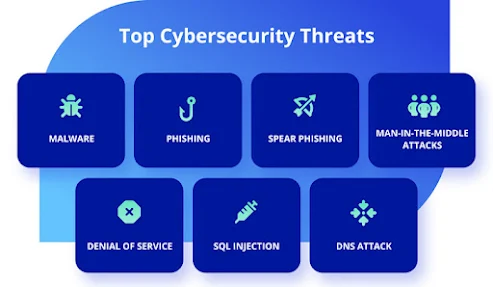Common IoT security threats
Some of the most common IoT security threats include:
Malware infections: Malware can be installed on IoT devices through a variety of methods, such as phishing attacks, malicious attachments, and software updates from untrusted sources. Once installed, malware can be used to steal data, disrupt operations, or launch attacks against other devices on the network.
Data breaches: IoT devices can be targeted by attackers to steal sensitive data, such as personal information, financial data, and intellectual property. This data can then be used for identity theft, fraud, or other malicious purposes.
Denial-of-service (DoS) attacks: DoS attacks can be used to overwhelm IoT devices with traffic, making them unavailable to legitimate users. DoS attacks can also be used to launch distributed denial-of-service (DDoS) attacks against other devices and systems on the internet.
Botnets: IoT devices can be infected with malware to create botnets, which are networks of compromised devices that can be used to launch attacks against other devices and systems on the internet. Botnets can be used to launch DDoS attacks, spread malware, and steal data.
How to secure specific types of IoT devices
Here are some tips for securing specific types of IoT devices:
Smart home devices: Smart home devices should be configured to only communicate with trusted devices and services. Additionally, strong passwords should be used for all smart home devices, and two-factor authentication should be enabled whenever possible.
Industrial control systems: Industrial control systems should be segmented from the rest of the network and monitored for suspicious activity. Additionally, all software updates for industrial control systems should be carefully reviewed before they are installed.
Wearable devices: Wearable devices should be encrypted and password protected. Additionally, wearable devices should only be connected to trusted devices and networks.
Best practices for IoT security
In addition to the tips above, there are a number of best practices that can be followed to improve the overall security of IoT devices:
Use strong passwords and change them regularly. This applies to all devices, including IoT devices.
Enable two-factor authentication whenever possible. Two-factor authentication adds an extra layer of security by requiring a second form of authentication, such as a code from your phone, in addition to your password.
Keep your devices up to date with the latest security patches. Security patches often include fixes for known vulnerabilities, so it is important to install them as soon as they are available.
Use a firewall to protect your network from unauthorized access. A firewall can help to block malicious traffic from reaching your devices.
Segment your network to isolate IoT devices from other devices on your network. This can help to prevent malware from spreading from one device to another.
Monitor your network for suspicious activity. There are a number of tools and services that can be used to monitor your network for suspicious activity, such as intrusion detection systems (IDS) and intrusion prevention systems (IPS).
By following these best practices, you can help to keep your IoT devices safe and secure.



